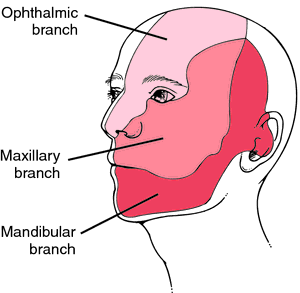Hi BlueRiver!
Welcome to our amazing forum. Sounds like your ES case is extra interesting (none are ever boring, mind you!). Styloids can break off from the skull base for many reasons, but the most common would be neck injury such as whiplash or falling. Sports injuries to head & neck can also create that scenario & even coughing hard or laughing hard can cause that to happen. It all depends on the angle, rigidity, length, etc. of your styloids & how they’re compromised by your activities. The stylohyoid ligaments actually connect to the lesser horns of the hyoid bone so more to the sides of the neck than to the Adam’s Apple area.
https://www.google.com/url?sa=i&rct=j&q=&esrc=s&source=images&cd=&ved=2ahUKEwijyPrB2d_iAhWS0J8KHaOhBkgQjRx6BAgBEAU&url=http%3A%2F%2Fnursingisinmyblood.tumblr.com%2Fpost%2F159992174245%2Feagle-syndrome&psig=AOvVaw3zqxh8FOuhmxdmcvCSmm2A&ust=1560282950613918
Your facial pain sounds related to trigeminal nerve irritation, but I’m not a doctor so please don’t take this as a diagnosis, just a possibility. A number of cranial nerves run through the area where the styloids “reside” & when the styloids elongate or the s-h ligament calcifies, these nerves can be impacted & thus create the crazy symptoms we get from ES. I’m attaching a picture below that shows the areas of the face affected by the trigeminal nerve. All are places you’ve mentioned having pain. Other nerves that we have most often noticed can be affected by ES are the vagus nerve (heart rate, vocal cords, anxiety levels, gastrointestinal issues), the hypoglossal & glossopharyngeal nerves (tongue, swallowing & speech), the axillary nerve (shoulder, arm & upper back pain), facial nerve (facial expressions & taste). My description of what each nerve influences is very general. You can Google cranial nerves & get more detailed info about each one & where each generally goes as it exits the skull.

The fact your parotid glands are irritated could explain why you have FBS. A few members have had it before surgery, but typically it doesn’t show up till post op. It’s a common side effect of surgeries in the part of the neck where the styloids are but also often resolves several weeks to several months post op.
Regarding surgery, it’s important to use a surgeon who has done a few (or many!) ES surgeries & is well acquainted w/ that part of the body - these are generally skull-based ENT surgeons or skull-based head & neck surgeons. Many are cancer specialists. There are several doctors on our US ES Doctors’ List who have done more than 300 ES surgeries each. Getting a second opinion from one of them is worthwhile even if it’s just to confirm what your doctor is telling you. I’m happy to give you names if you’re interested.
If you do consider surgery, it’s also important for you to know your surgeon’s surgical strategy - i.e. intraoral or external approach; both sides at once or one at a time; hospital stay or outpatient? We generally advocate the external approach for several reasons - better access to the styloid & s-h ligament so they can be completely removed from skull base to hyoid bone AND nerves & vascular tissues can be monitored. There is also less chance of infection w/ external surgery. Intraoral is through the throat & access to the styloid process is limited & there is little or no access to the s-h ligament. That said, there are a few doctors, who by making multiple incisions in the throat & roof of the mouth, have been able to remove the styloid fully & some of the ligament using intraoral surgery. Nerves & vascular tissues aren’t visible or able to be monitored as well this way. We do have forum members who’ve had good results w/ intraoral surgery. External surgery isn’t perfect either but does seem to be a bit safer.
If you feel comfortable about it, you can post a 3D picture of your CT scan so we can see your styloids & ligaments. It’s always interesting to see different cases of ES. Most of us are not so good at understanding what we’re seeing in CT slices though.
My styloids were long & ligaments partially calcified. I had a wide range of symptoms which started w/ neck pain. If you search my posts, I did list all my crazy symptoms some years ago (I’ve been a member since 10/14) & perhaps you can read them there.
Thank you for jumping into our conversations so quickly after joining. I hope you’re able to get great information & feel supported by this wonderful community!



